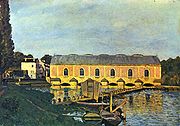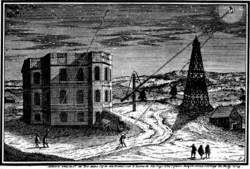
Machine de Marly
Encyclopedia

France
The French Republic , The French Republic , The French Republic , (commonly known as France , is a unitary semi-presidential republic in Western Europe with several overseas territories and islands located on other continents and in the Indian, Pacific, and Atlantic oceans. Metropolitan France...
engineering marvel (though Arnold de Ville and Rennequin Sualem would be Belgians, by current geography) completed in 1684. King Louis XIV needed a large water supply for his fountains at Versailles
Versailles
Versailles , a city renowned for its château, the Palace of Versailles, was the de facto capital of the kingdom of France for over a century, from 1682 to 1789. It is now a wealthy suburb of Paris and remains an important administrative and judicial centre...
. The amount of water needed per day for these fountains was not much less than the amount of water used per day in the city of Paris
Paris
Paris is the capital and largest city in France, situated on the river Seine, in northern France, at the heart of the Île-de-France region...
.
The Machine de Marly, based on a prototype at Modave Castle, consisted of fourteen gigantic water wheels, each roughly 11.5 meters or 38 feet in diameter, that moved 221 pumps to bring water 177 yards (161.8 m) up a hillside from the Seine
Seine
The Seine is a -long river and an important commercial waterway within the Paris Basin in the north of France. It rises at Saint-Seine near Dijon in northeastern France in the Langres plateau, flowing through Paris and into the English Channel at Le Havre . It is navigable by ocean-going vessels...
River to the Louveciennes Aqueduct
Aqueduc de Louveciennes
Laqueduc de Louveciennes , sometimes called aqueduc de Marly is an aqueduct built in under the reign of Louis XIV, located in Louveciennes . Now out of service, the aqueduct is listed as Monument historique since 1953...
. King Louis XIV had countless schemes and inventions that were supposed to bring water to his fountains. The Machine de Marly was, by far, his most extensive and costly plan. After three years of construction and a cost of approximately 4,000,000 livres
French livre
The livre was the currency of France until 1795. Several different livres existed, some concurrently. The livre was the name of both units of account and coins.-Etymology:...
, the massive contraption was completed. The chief engineer for the project was Arnold de Ville and the "contractor" was Rennequin Sualem
Rennequin Sualem
Rennequin Sualem was a Walloon carpenter and engineer Rennequin Sualem was a Walloon carpenter and engineer Rennequin Sualem was a Walloon carpenter and engineer (Jemeppe-sur-Meuse (Walloon Country) 1645 - Bougival (France 1708 ).In 1667-1668 Lieutenant-Governor of the castle of Huy ordered the...
(after whom the quai by the machine is now named). , the symbol of the Liège' s success in the hydraulics because of the coalmines.
However, the machine suffered from frequent breakdowns, required a permanent staff of sixty to maintain and often required costly repairs.

Versailles
Versailles , a city renowned for its château, the Palace of Versailles, was the de facto capital of the kingdom of France for over a century, from 1682 to 1789. It is now a wealthy suburb of Paris and remains an important administrative and judicial centre...
not long after the machine's completion.
Despite its name, the Machine de Marly was located on the territory of the commune
Communes of France
The commune is the lowest level of administrative division in the French Republic. French communes are roughly equivalent to incorporated municipalities or villages in the United States or Gemeinden in Germany...
of Bougival
Bougival
Bougival is a commune in the Yvelines department in the Île-de-France region in north-central France. It is located in the western suburbs of Paris from the center....
.

